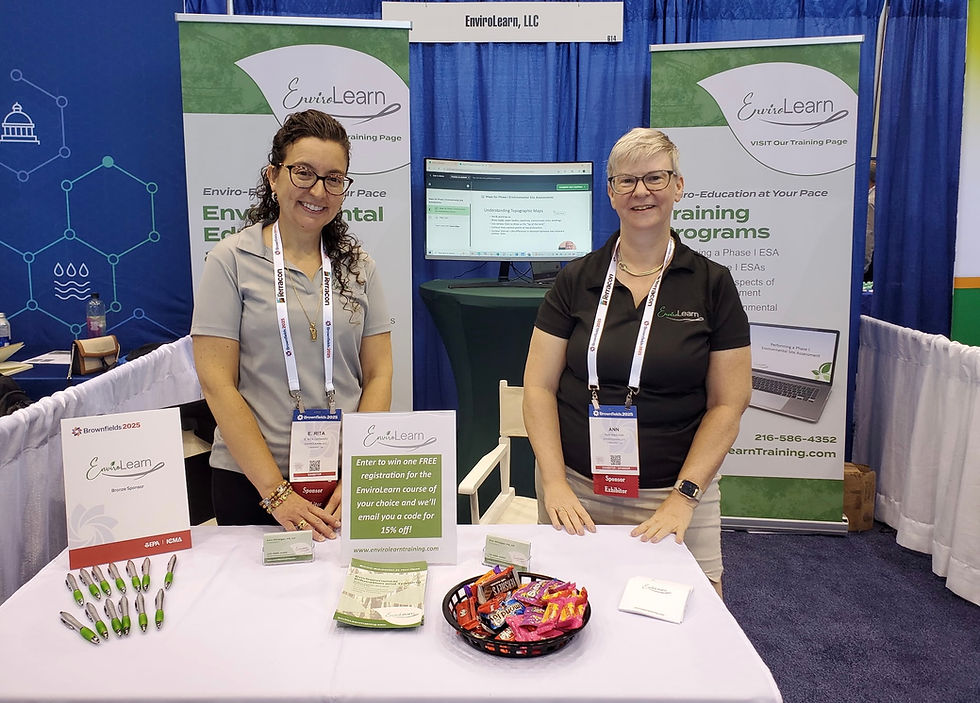Turning Challenges into Opportunities: 10 Tips for Successful Brownfield Redevelopment
- Ann Winegar
- Oct 28
- 4 min read

With the 2025 National Brownfield Training Conference fresh in my mind, and while working on some brownfield projects myself, I’ve been thinking about how local governments and environmental consultants can successfully redevelop brownfields together. Brownfield sites—properties complicated by real or perceived contamination—represent both a challenge and an opportunity for communities. For local governments, they’re a chance to transform blighted land into economic engines. For environmental consultants, they’re complex but rewarding projects that combine science, strategy, and community engagement.
When approached collaboratively, brownfield redevelopment can spark revitalization, attract investment, and improve public health and the environment. Here are 10 key tips to help municipalities and consultants achieve successful, sustainable outcomes together.
1. Begin with a Comprehensive Site Assessment
Every successful redevelopment starts with understanding the site’s history and condition.
Local Governments: Commission or facilitate a Phase I Environmental Site Assessment (ESA) to identify potential contamination and historical uses. This is a critical first step before property acquisition or redevelopment planning.
Consultants: Ensure assessments follow ASTM standards and clearly communicate findings in plain language for nontechnical stakeholders.
If warranted, a Phase II ESA should follow to confirm and delineate contamination. Other assessments for asbestos-containing building materials, lead-based paint, and hazardous materials may also be needed. Early clarity reduces surprises later.
2. Build Early, Transparent Stakeholder Engagement
Community buy-in can make or break a brownfield project.
Local Governments should organize listening sessions and maintain open communication with residents, regulators, and potential developers.
Consultants can play a vital role by translating technical information into accessible formats and participating in public meetings to address environmental concerns.
Transparency builds trust—and trust accelerates progress.
3. Navigate Regulations Strategically
Understanding environmental and land-use regulations early prevents costly missteps.
Local Governments: Coordinate with state and federal regulators to clarify cleanup responsibilities and explore programs such as the EPA Brownfields Program or Voluntary Cleanup Programs (VCP).
Consultants: Guide clients through regulatory requirements, documentation, and reporting, ensuring all stakeholders align on cleanup standards and end-use goals.
Proactive, early communication with regulators often results in faster reviews and clearer expectations.
4. Pursue Grants, Incentives, and Partnerships
Brownfield redevelopment is capital-intensive, but numerous funding streams exist.
Local Governments: tap EPA and state brownfield grants, revolving loan funds, and tax incentives to offset assessment and cleanup costs.
Consultants: support local governments in identifying and applying for grants and other funding, preparing technical work plans, and ensuring compliance with funding requirements.
Jointly pursuing funding opportunities can make otherwise unfeasible projects viable.
5. Assemble a Multidisciplinary Team
Brownfield redevelopment touches nearly every discipline—natural sciences, engineering, law, finance, planning, and public engagement.
Local Governments: Designate a project lead or interdepartmental task force to coordinate efforts.
Consultants: Bring technical and regulatory expertise while collaborating seamlessly with planners, developers, and legal teams.
A well-coordinated team bridges the gap between environmental reality and community vision.
6. Manage Risk and Liability Proactively
Fear of liability is a common barrier to redevelopment.
Local Governments: Use legal tools such as land banks, agreements with developers, and liability protections under EPA or state programs to reduce risk.
Consultants: Help define contamination boundaries, develop risk-based cleanup plans, and support clients in obtaining environmental insurance.
Mitigating liability early makes projects more attractive to private partners and investors.
7. Align Cleanup with Future Land Use
Cleanup strategies should reflect the site’s intended reuse—whether industrial, commercial, residential, or recreational.
Local Governments: Integrate brownfield cleanup into broader community planning or zoning updates.
Consultants: Design remedial approaches that meet applicable standards while being cost-effective and tailored to the end-use.
Cleanup and redevelopment should be planned as one cohesive process, not two separate efforts.
8. Incorporate Sustainability and Resilience
Redeveloped brownfields can set the standard for sustainable urban growth.
Local Governments: Encourage green infrastructure, renewable energy integration, and climate-resilient design through zoning incentives or sustainability guidelines. Consider how the redevelopment can be readily adapted to address changes in community needs in the long-term.
Consultants: Recommend technologies like permeable pavements, native landscaping, and adaptive reuse of structures to reduce environmental footprints.
A sustainable approach not only improves environmental outcomes but can also unlock additional funding and community support.
9. Share Success and Celebrate Progress
Publicizing milestones helps maintain momentum.
Local Governments: Highlight success stories through community events, media outreach, and redevelopment showcases.
Consultants: Document project data, before-and-after photos, and environmental metrics to demonstrate impact and attract future clients.
A visible success story can inspire confidence, attract new investment, and encourage replication across other sites.
10. Plan for Long-Term Stewardship
Even after redevelopment, some sites require monitoring or institutional controls.
Local Governments: Establish clear ownership, maintenance, and compliance plans for long-term site management.
Consultants: Provide post-remediation monitoring services and support ongoing regulatory reporting.
Sustained stewardship protects both public health, the environment, and the project’s legacy.
Moving Forward
Brownfield redevelopment is most successful when local governments and environmental consultants act as true partners—combining vision, technical expertise, and community engagement. Together, they can transform idle or contaminated land into assets that support economic growth, environmental quality, and civic pride. Every brownfield represents not just a challenge, but a chance to build a cleaner, more sustainable future.





Comments